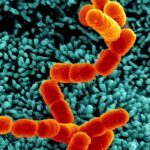Link to Pubmed [PMID] – 29702107
J. Mol. Biol. 2018 Jun;430(12):1714-1724
Nucleocytoplasmic large DNA viruses are a steadily growing group of viruses that infect a wide range of hosts and are characterized by large particle dimensions and genome sizes. Understanding how they enter into the host cell and deliver their genome in the cytoplasm is therefore particularly intriguing. Here, we review the current knowledge on the entry of two of the best-characterized nucleocytoplasmic large DNA viruses: the poxvirus Vaccinia virus (VACV) and the giant virus Mimivirus. While previous studies on VACV had proposed both direct fusion at the plasma membrane and endocytosis as entry routes, more recent biochemical and morphological data argue for macropinocytosis as well. Notably, direct imaging by electron microscopy (EM) also supported the existence of parallel ways of entry for VACV. Instead, all the giant viruses studied so far only enter cells by phagocytosis as observed by EM, and we discuss the mechanisms for opening of the particle, fusion of the viral and phagosomal membranes and genome delivery via a unique portal, specific for each giant virus. VACV core uncoating, in contrast, remains a morphologically ill-defined process. We argue that correlated light and electron microscopy methods are required to study VACV entry and uncoating in a direct and systematic manner. Such EM studies should also address whether entry of single particles and viral aggregates is different and thus provide an explanation for the different modes of entry described in the literature.
